
Features
Aggregates
Profiles
Athabasca’s Big One and More
From the equipment to the production numbers and investments, everything in the Fort McMurray area
April 17, 2012 By Bill Tice
It’s minus 24 C and Dom Kriangkum is navigating his way around piles of
gravel with a tape measure in one hand and a note pad in the other.
It’s minus 24 C and Dom Kriangkum is navigating his way around piles of gravel with a tape measure in one hand and a note pad in the other. Although his face is partially obscured with a hat and scarf needed to combat the cold wind, you can still sense his excitement. You also get the impression that he is definitely a “hands-on” CEO who brings his personal interest and enthusiasm to every project his company undertakes.
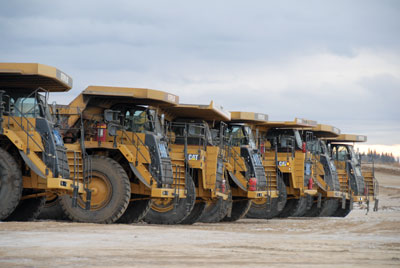 |
|
| Athabasca’s Susan Lake operation is the largest open pit gravel operation in Canada.
|
On this winter day, Kriangkum, who is an engineer and also the president and CEO of Edmonton-based Athabasca Minerals Inc., is in the Kearl Pit, which is about a 90-minute drive northeast of the oil sands city of Fort McMurray, Alta. He’s here with Murray Humphries, who is the area manager at Athabasca’s Susan Lake operation, which is located just over an hour west of the Kearl Pit. The pair are collecting measurements from the 32-hectare (80-acre) site, and from these measurements, Kriangkum and his staff will be able to calculate projected aggregates volumes from the area, which will go into production in 2012.
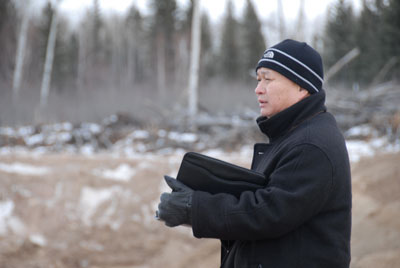 |
|
| Dom Kriangkum estimates that they excavated over seven million tonnes of sand and gravel from the operation at Susan Lake.
|
The production from the Kearl Pit will run simultaneously with Athabasca’s Susan Lake operation, which is the largest open pit gravel operation in Canada. The biggest production year ever at Susan Lake was in 2008, when almost 12 million tonnes of product were extracted from the pit. Last year, Kriangkum estimates that they excavated over seven million tonnes of sand and gravel from the operation, most of which was used in the oil sands. But, he says, the supply from Susan Lake won’t last forever.
“We are looking long term,” he explains. “We know the Susan Lake operation could last for another 10 years or more, but we want to make sure we can continue in this business indefinitely and that is why we need to be sourcing aggregates from other areas now, such as the Kearl Pit.”
Small steps
On the soon-to-be-active Kearl site, the company has some leased equipment, including a McCloskey S190 portable screening plant and a pair of McCloskey 36-inch conveyors – one 125-foot model and one 80-foot model. Once Athabasca gets up and running, screening and loading will be handled at the site. This is new for the company, since at Susan Lake it is strictly the pit manager, which involves clearing and stripping, handling the weigh scales, co-ordinating the contractors that are coming and going from the site and collecting revenues for Alberta Sustainable Resource Development.
“At Susan Lake, the Crown is our boss,” says Kriangkum. “It is the owner of the Susan Lake pit and we manage it on the Crown’s behalf.”
Susan Lake operations
Kriangkum, who is originally from Thailand and immigrated to Canada in 1970, says the Susan Lake operation is 3,750 hectares, (9,260 acres) – enough space to house over 6,200 football fields. However, he adds that only about 25 per cent of this area – or 935 hectares (2,310 acres) – has been developed for aggregate extraction since 1998.
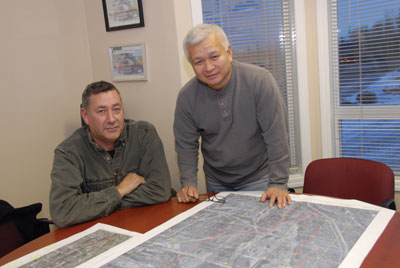 |
|
| Murray Humphries, left, and Dom Kriangkum of Athabasca Minerals. The company is looking to produce FRAC sand in addition to existing work at Susan Lake and the Kearl Pit.
|
Athabasca Minerals, a public company listed on the TSX Venture Exchange, was formed and went public in 2006. Prior to that, Kriangkum and two of his business partners, Shaun O’Connor-Parsons and Dale Nolan, operated a company called Aggregates Management Inc. (AMI), which ran the Susan Lake pit from 1998 to 2008, when Athabasca purchased AMI. Today, Athabasca Minerals has 25 personnel, with approximately 60 per cent of its workforce situated in the Fort McMurray area, and the remainder located in Edmonton.
Kriangkum says they currently use contractors to handle the clearing and stripping at Susan Lake, but adds that they are starting to rent equipment and hire their own operators to handle this process as it gives them more control. However, he stresses that clearing and stripping is the extent of the production work Athabasca completes at this site. The actual crushing, screening, washing and trucking is all handled by production companies in the area who fill orders from the major oil sands producers.
“We don’t compete against these companies,” Kriangkum explains. “Our mandate is to maximize the amount of gravel that is coming out of the Susan Lake operation.”
Humphries agrees, noting that they must make sure all of the sand and gravel contractors working in the Susan Lake pit are treated equally. “We can’t play favourites with which contractor gets to work in which area of the pit and we certainly don’t want to be competing with these companies. Our challenge is to effectively manage the aggregate demands of the contractors that are working here and to make sure they can all fulfil their aggregate orders.”
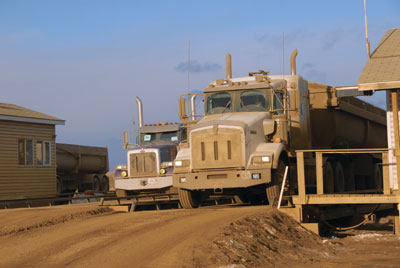 |
|
| To keep everything moving, the Susan Lake operation has three truck scales, with a fourth one ordered.
|
At present, Humphries says through the sand and gravel companies, Susan Lake has seven crushing operations, two wash plants and two screen areas. On a busy winter day, he says upwards of 1,300 trucks will cross the scales, while in the summer months, he says that number will jump to around 1,500.
“Those are our busy days, but even on an average day, we have 1,000 trucks crossing the scale and the average truck has 32 tonnes of material on it,” he explains. “Right now we have four or five contractors working in here at any given time, so although it is busy, it is manageable.”
To keep everything moving, the Susan Lake operation has three truck scales, with a fourth one ordered. The new scale, which cost around $150,000, is being manufactured by Pacific Scale in Edmonton. “It will be able to handle the newer and larger 400-tonne trucks,” Humphries notes.
With that many trucks coming and going every day, it takes a major amount of co-ordination to keep up with the paperwork. “Every morning we talk to the companies that are working at Susan Lake and they give us a list of how many trucks they are projecting for the day and what location they are working in, but of course it can change and often does,” Humphries adds. “Once per month, we tare the trucks to get their empty weight, and then they are weighed each time they leave the property.”
A printed ticket that matches the truck tells Athabasca Minerals who bought the load, what it contained, where it is going, and which customer to invoice. “The gravel business is not glamorous, but it pays the bills,” jokes Kriangkum who adds that Athabasca Minerals makes its money from user fees. “We receive a set rate for every tonne that leaves here, but we have to pay all of our costs out of that, including land clearing and stripping.
Revenues
The user fee collected for every truck leaving the Susan Lake operation is about $1.00 per tonne. Kriangkum explains that in addition to the user fee, the customer is also charged a government royalty on aggregates of roughly 50 cents per tonne.
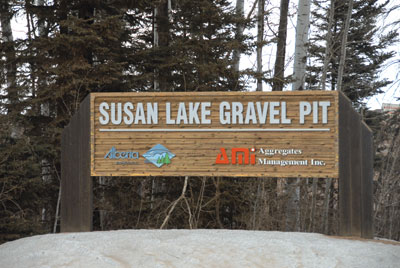 |
|
The contractors then have to pay for the costs of processing the material and trucking it to the customer, but the end price they are paid by the customer for the delivered product is set by the market. Regardless of the end price paid by the customer, Athabasca Minerals’ gross revenue per tonne of material leaving the operation is the same.
“We are actually the smallest and least expensive part of the equation,” Kriangkum notes. “However, it has been profitable for us and we expect it will continue to be profitable.”
With the continued development of the oil sands, Athabasca Minerals should continue to be busy. Kriangkum estimates that a typical open pit mine in the Fort McMurray area will consume eight to 10 million tonnes of gravel per year, just for pads, and then another 500,000 tonnes to one million tonnes per year on average, just to maintain the site. “That’s for the life of the mine,” he adds. “That has a huge impact on a lot of people. It creates jobs and stimulates the economy.”
Other Pits
In addition to the Susan Lake and Kearl Pit operations, Athabasca Minerals also has access to several other operations in the area. The company recently began supplying aggregates for a twinning project on Alberta Highway 63 from the House River pit, while at the Poplar Creek Gravel Pit, Athabasca will be completing some evaluations in the near future to see what aggregates volume is available from the site. The company’s two other pits in the area – Logan and Pelican Hills – are currently inactive. In total, Athabasca Minerals holds Alberta Metallic and Industrial Minerals Permits for more than 227,282 hectares (561,626 acres) in the region.
Kriangkum and his partners at Athabasca have been committed to the aggregates business in Alberta’s Oil Sands for many years, going back to when oil coming out of the area only fetched $12 per barrel. “We like to think this has been a very good business for us,” Kriangkum says. “When we came here in 1998, we crossed what was called ‘the bridge to nowhere’ as there literally was nothing here at the time. We are really glad that Shell, Syncrude and others committed to this area and this business for the long term, as without that commitment, we would not be where we are today.”
| Growth Potential Athabasca Minerals Inc. may be up to two years away from producing FRAC sand, but according to company president and CEO Dom Kriangkum, it’s a product that could provide the company with significant growth potential. Kriangkum says Athabasca, which up until now has focused on running the Susan Lake sand and gravel operation west of Fort McMurray, Alta., has a lease on 12,800 hectares (31,629 acres) of land located 30 kilometres north of Susan Lake. “We have done tests and proven that the area contains a significant amount of sand that will be suitable for FRAC sand,” Kriangkum explains. “We are also bringing in an independent geologist to confirm that the sand from this area will be suitable.” FRAC sand has to be high in silica content and it has to have a specific roundness, and be able to withstand high pressure. Often referred to as “white gold,” FRAC sand is used in the hydraulic fracturing, or fracking process, which is a controversial method of extracting natural gas from deep deposits. Fracking is controversial because it may typically use a mixture of 90 per cent water, seven per cent FRAC sand and three per cent chemicals. It has been reported that the chemicals used in the fracking process have been responsible for contaminating groundwater and other environmental problems. High energy prices have increased the demand for natural gas, which has driven FRAC sand prices through the roof. The Alberta land Athabasca has leased is fairly close to natural gas deposits in Western Canada. “Our market would be Western Canada,” Kriangkum explains. “We would process the material on site and then truck it to a terminal in Fort McMurray where it would be transferred to railcars that could move it to northeastern B.C. and northern Alberta and Saskatchewan.” Kriangkum adds that right now, most of the FRAC sand used in Western Canada is imported from the United States. “This would put us on the map as a major FRAC sand supplier and with the long-term projection of demand for oil and gas increasing, we feel there is lots of opportunity here for significant growth.” |
Print this page